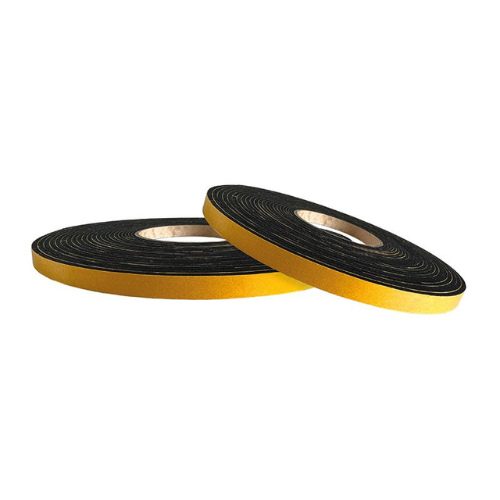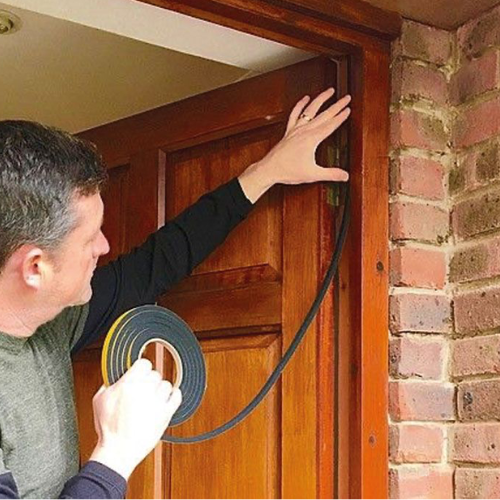Energy efficiency is crucial for homeowners and tenants looking to lower their utility cost and minimise environmental impact. One of the primary contributors to high energy bills is energy loss, which occurs when heated or cooled air escapes through gaps around windows, doors and openings in the home. In this blog post, we’ll explore how simple measures like using Rubber Weatherstrip can help you combat energy loss and achieve greater energy efficiency in your home.
What is a Rubber Weatherstrip?
A rubber weatherstrip is a flexible sealing material, used to fill gaps and spaces around windows, doors and other openings in your building. Manufactured from high-quality closed-cell Neoprene/EPDM sponge rubber, weatherstrips offer outstanding durability and insulation properties.
Designed to provide a tight seal, rubber weatherstrips effectively block out drafts, moisture and outside noise, creating a more comfortable and energy efficient environment. The closed-cell structure of EPDM/Neoprene sponge is not only waterproof, but offers compressibility and resilience, allowing the weatherstrip to conform to irregular surfaces and maintain its sealing effectiveness over time.
Rubber weatherstrips are easy to install and require minimal maintenance, making it a cost-effective solution for sealing doors and windows in residential and commercial buildings alike. Whether you’re looking to reduce energy bills, increase comfort, or minimise outdoor noise, rubber weatherstrips offer reliable protection and long-lasting performance.

How do Rubber Weatherstrips Reduce Your Energy Bills?
Rubber weatherstrips offer a simple, yet effective solution for reducing energy bills in your home. By sealing gaps and spaces around windows, doors, and other openings, rubber weatherstrips prevent heated or cool air from escaping and outdoor air from infiltrating. This helps maintain a consistent indoor temperature, reducing the workload on your heating and cooling systems and ultimately lowering your energy consumption.
Prevents Air Leakage
One of the primary benefits of rubber weatherstrips is their ability to prevent air leakage. Gaps around windows and doors are common sources of energy loss in homes, allowing condition air to escape and outdoor air to enter. By sealing these gaps with rubber weatherstrips, you can significantly reduce the amount of energy needed to heat or cool your home, leading to lower energy bills.
Improves Insulation
Rubber weatherstrips act as insulating barriers, effectively blocking drafts and reducing heat transfer between the interior and exterior of your home. This improved insulation helps maintain a more comfortable indoor environment year-round, reducing the need for heating and cooling systems to run continuously that increase your energy bill costs.
Enhances Energy Efficiency
By enhancing the energy efficiency of your home, rubber weatherstrips help optimise the performance of your heating and cooling systems. With less energy wasted on heating and cooling air that escapes through gaps, your HVAC systems can operate more efficiently, consuming less energy and reducing your overall energy bills month on month.
Mimises Energy Waste
In addition to saving money on your energy bills, rubber weatherstrips help minimise energy waste and reduce your environmental footprint. By reducing the amount of energy needed to maintain a comfortable indoor environment, you can contribute to conservation efforts and promote sustainability.
Long-Term Savings
While the upfront cost of installation of rubber weatherstrips is already fairly low, the long term savings they can provide is significant. By reducing your energy bills month after month, year after year, rubber weatherstrips offer a cost-effective way to improve the energy efficiency of your home and save money over time.

How to Install Rubber Weatherstrips On Your Doors & Windows
Follow these steps to properly install, use and maintain rubber weatherstrips on both your doors and windows:
- Clean the Surface – Start by cleaning the surfaces around the window or door frames where the rubber strip will be applied. Use a mild detergent and water to remove any dirt, dust, or debris that could interfere with adhesion.
- Measure the Gaps – Carefully measure the length of the gaps between the window and door frames and the adjacent surfaces, such as the window sills or door jambs. This will help you to determine the length of rubber weatherstrip needed for proper sealing.
- Cut the Weatherstrip – Using sharp scissors or a utility knife, cut the rubber weatherstrip to the appropriate lengths based on your measurements for both windows and doors. Be sure to make clean, straight cuts to ensure a proper fit.
- Apply the Weatherstrip – Peel of the backing to reveal the self-adhesive on the rubber weatherstrip. Now, carefully press it into place along the gaps between the window or door frames and the adjacent surface. Apply firm pressure to ensure proper adhesion.
- Seal Any Gaps – If there are any gaps or irregularities in the window and door frames that cannot be covered with a single strip of rubber weatherstrip, use additional pieces to fill in the gaps and create a continuous seal.
- Test for Effectiveness – Once the rubber weatherstrip is installed, close the windows and doors to check for any gaps or drafts. If necessary, make adjustments or add additional weatherstrips to ensure a tight seal.
- Maintenance and Care – Regularly inspect the rubber weatherstrip for signs of wear and damage, such as cracking or peeling. Replace any worn weatherstrips promptly to maintain optimal sealing effectiveness and energy efficiency.
Can Rubber Weatherstrips Be Used In Other Areas Of Your Home?
While rubber weatherstrips are commonly used around windows and doors to improve energy efficiency and help to reduce your overall energy bills, they can also be used in other areas of your home for insulation. Here are some additional areas where rubber weatherstrips can be beneficial:
- Attic Hatches – Attic hatches are often overlooked sources of energy loss in homes. By installing rubber weatherstrips around the edges of the attic hatch, you can prevent heated or cooled air from escaping into the attic space, helping to maintain a consistent indoor temperature and reduce your energy bills.
- Electrical Outlets – Electrical outlets on exterior walls can be significant sources of drafts and energy loss. By installing rubber weatherstrips behind outlet covers, you can create tight seals and prevent air infiltration, improving energy efficiency and reducing drafts in the home.
- HVAC Ducts – Leaky HVAC ducts can waste energy by allowing conditioned air to escape into unconditioned spaces such as attics. By sealing gaps and joints in HVAC ducts with a rubber weatherstrip, you can improve the performance of your heating and cooling system to reduce energy bills.
- Garage Doors – Garage doors are yet another area where rubber weatherstrips can be used. Installation rubber weatherstrips along the bottom of the garage door can help seal out drafts, dust, and pests, creating a more comfortable and energy efficient garage space.
- Interior Doors – While rubber weatherstrips are commonly used on exterior doors to prevent drafts, they can also be used on interior doors to improve sound insulation and privacy. Installing rubber weatherstrips around the edges of interior doors can help reduce noise transmissions between rooms and create a quieter indoor environment.
Where to Buy Rubber Weatherstrips For Doors and Windows
Looking for high-quality rubber weatherstrips for doors and windows to improve the energy efficiency and comfort of your home? Look no further, at Delta Rubber Limited we offer a wide selection of closed-cell EPDM/Neoprene sponge weatherstrips, also known as weatherstrip tape, available to purchase online by Clicking Here.
Why Choose Delta Rubber Limited?
- Premium Quality – Our rubber weatherstrips are made from durable closed-cell EPDM/Neoprene sponge, ensuring superior performance and longevity.
- Versatile Options – Choose from a range of sizes to suit your windows and doors in your home. Our standard weatherstrip tape is sold in 10 metre lengths, with thicknesses of 4mm, 6mm or 8mm, and widths of 10mm or 12mm, suitable for most standard doors and windows in the UK.
- Affordable Pricing – Our rubber weatherstrip for doors and windows is priced from just £8.40 ex. VAT, making it a cost-effective solution for improving your energy efficiency and reducing your overall energy bills.
- Wide Range of Sizes – If you require a larger size weatherstrip tape, we’ve got you covered. Click Here to browse our full range with widths from 10mm to 500mm and even more thicknesses to choose from, ensuring you find the perfect fit for your sealing needs.
How to Order:
- Visit our Website – To browse our full selection of rubber weatherstrip and cut rubber strip products, visit our easy-to-use online shop.
- Easy Ordering Process – Our website offers a user-friendly ordering process, allowing you to select the desired size, quantity and thickness of your weatherstrip tape to suit your specific requirements.
- Fast Delivery – We understand the importance of prompt delivery. Once your order is placed, we’ll ensure swift dispatch and fast delivery using our reliable courier service to your doorstep, meaning you can start reducing your energy bills right away!
Don’t let drafts and energy loss compromise the comfort and efficiency of your home. Invest in high-quality rubber weatherstrips from Delta Rubber Limited today and start saving money on your energy bills.
Frequently Asked Questions (FAQ’s)
Is there a way to reduce my energy bills?
Yes, using rubber weatherstrips on doors and windows is an effective way to reduce energy bills by preventing drafts and improving insulation.
My energy bills are high, what can I do?
Installing rubber weatherstrips can help to lower your energy bills by sealing gaps and preventing warm air leakage, reducing the workload on your heating.
Why is weatherstripping good for energy efficiency?
Weatherstripping improves energy efficiency by sealing small gaps and preventing air infiltration, reducing heating and cooling costs and improving indoor comfort.
How much money can I save on energy bills?
The amount of money you can save on your energy bills by using rubber weatherstrip varies depending on factors such as the size of your home and existing energy efficiency measures. However, many homeowners experience noticeable savings over time.
How can I work out what size rubber weatherstrip I need for my home?
To determine the size of the rubber weatherstrip needed for your home, measure the gaps around windows and doors where the weatherstrip will be installed. Choose a weatherstrip tape size that provides a snug fit and seals the gaps effectively.
How soon can I expect to see a difference in my energy bills after installing rubber weatherstrips?
The timeframe for seeing a difference in energy bills after installing rubber weatherstrips can vary depending on factors such as the extent of air leakage and existing insulation. However, many homeowners notice improvements in energy efficiency and comfort shortly after installation, with significant cost savings over time.



